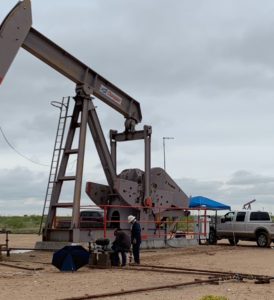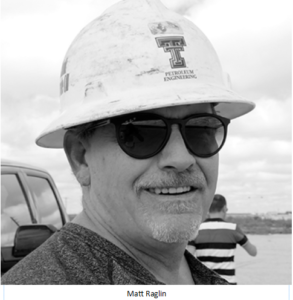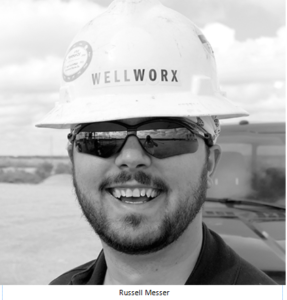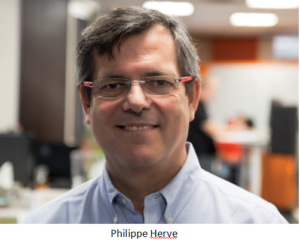Wells and technology both get more complex. Companies are applying their best minds, and best thinking, to the task of staying up with the changes.
By Paul Wiseman
“Sometimes I think—me personally, or WellWorx or the industry—that we’ll run out of ways to innovate or we’ll run out of good ideas,” said Matt Raglin, founder and CEO of WellWorx Energy.
“But we never do. We get challenged and then we get to work,” he said. And the innovations continue.
Raglin, a 40-plus-year veteran of the oil patch, pointed out that “new wells require new technology.” This is necessary for two main reasons. One, older technology may have worked well for simple vertical wells in conventional plays, but it doesn’t work in multi-stage, miles-long-lateral unconventional wells. The second reason is that much of the older technology never really worked anyway—it was just the best that could be done before computer modeling and the wealth of collected data available today.
One WellWorx product came about for the second reason—older methods for taking fluid level readings were known to be inaccurate, especially with larger volumes. The industry felt it had to live with the issue because it’s all there was.
Decades ago, however, two men knew there had to be a better way. WellWorx is about to release Greenshot, the result of their decades of research and development.
Back in 1995 industry legends Ken Nolan and the late Dr. Sam Gibbs were with Nabla, an artificial lift company that was later bought out by Lufkin. They already had such industry standards as the pump off controller and the downhole card in their list of credits.
The pair felt that the industry should have a fluid level tool that lived onsite, taking regular readings to get a much clearer and accurate picture of the well’s performance. This was to be in lieu of the common option of shooting one fluid level at a time with great intervals in between.
Nolan’s grandson Russell Messer, who is WellWorx’s Greenshot product line manager, explained the long lag time: “For various reasons, patents being one of them, they [Nolan and Gibbs] weren’t able to deep-dive that idea.” The off-putting patents expired in 2012, freeing the pair to begin research and development on what became Greenshot.
Raglin explained the concept: “Greenshot is an autonomous fluid level, pump-intake-pressure device that can be on every well. The term ‘green’ means that we don’t emit any gas, because we use the well’s energy. Other methodologies are going to emit gas to the atmosphere or require some foreign gas be introduced to the well.”
 Nolan and Gibbs wanted a device that would “live” on every well, collecting and transmitting data to a SCADA system. This would boost accuracy as well as efficiency by providing a stream of data without any site trips.
Nolan and Gibbs wanted a device that would “live” on every well, collecting and transmitting data to a SCADA system. This would boost accuracy as well as efficiency by providing a stream of data without any site trips.
The inventors’ mantra, according to Raglin, was, “Don’t touch it if you can’t do it right.”
Raglin and a number of industry partners believe they did “do it right.” WellWorx bought Greenshot from the inventors in 2018, for the purpose of field testing, tweaking as needed, and bringing it to market.
“We’re very fortunate,” said Raglin, “that we’ve had some very good partners—oil operators—that have worked with us and allowed us to use wells for guinea pigs. Those would include Pioneer, Henry Petroleum, and Diamondback.”
How does Greenshot work? The website lists three functions, paraphrased here:
GreenShot infers gas production through the casing without using a standard orifice meter. Every five minutes or so the system closes the casing valve and measures pressure buildup in one-minute increments. It calculates gas flow using a formula based on physics, using the trapezoid rule. At day’s end GreenShot has summarized the casing rate mcf/d.
It also automatically shoots a fluid level acoustically, powered by the well’s own energy, in a closed system. GreenShot then uses the fluid level to compute parameters indicating the well’s production potential.
Combining its own test results with readings from the pump-off controller, the system provides continuous well tests. Using the downhole pump as a meter, the POC estimates oil, gas, and water production through the tubing. As GreenShot estimates gas produced through the tubing, it provides the total production stream.
At this writing the product had not been released to the public—release date is scheduled for summer, 2019—but word had spread through the community based on the preliminary tests and through an award. Messer noted that the process won the 2018 Hearst Technology Award presented at the Executive Oil Conference—when Greenshot was months away from being released.
Many of the companies whose wells were used in the trial phase “are reaching out to us, saying, ‘We want to get our hands on this technology.’ That never, ever, ever has happened to me before,” he declared.
The need for innovation is endless, but Messer and Raglin feel it must be managed to meet actual needs.
“I think there’s a lot of data coming out for data’s sake,” said Messer. Admitting that a lot of collected data is improving performance in multiple areas, Messer’s caution is that every advancement brings with it new challenges. “About the time we get a handle on these wellbores and these reservoirs [based on new data], what do we do? We get smart, we get better at frac’ing, we get more production capabilities, the reservoirs change—and now we have more advanced problems. With every single one of those changes, you’ve gotta have the equipment to keep up.”
As examples of this leapfrog effect, Raglin recalled landmarks in production complexity such as the introduction of CO2 floods “which introduced a layer of complexity,” multilayered Wolfberry wells in about 2000, “that brought new challenges.” At that time a previous Raglin company, Spirit Energy, worked with clients on new methods because, “we worked with our operators because we needed new technology and new practices to fit these new types of wells—the behavior was just different.”
Today’s horizontal wells, with miles-long laterals twisting and undulating through varying formations, require even more new technology like GreenShot and more. “What we did in the Wolfberry doesn’t work anymore either,” Raglin pointed out.
When asked if the interactive complexity of wells and technology is a sort of “chicken-or-the-egg” situation, Raglin agreed, adding, “The drilling department has always done a fantastic job of making the production department’s life complex.”
Not only does change continue, the increase in the speed of change ramps up as well, said Philippe Herve, vice president of solutions for international tech giant SparkCognition. “Things have been changing for a long time, and the rate of change is really what makes it tremendously interesting. What was impossible six months ago is possible today, and what we cannot do today we will be able to do in six months. Just trying to stay up to speed is a challenge.”
Herve credited SparkCognition’s ongoing success across oil and gas in multiple industrial categories with the company’s deep research into automation and data science. “Data science is absolutely a growing market.”
He pictures the work of a data scientist to be receiving a batch of data, retreating with it for a given amount of time, then emerging with “the model that you can use and hone the model and try to produce a future in real time.”
With the flood of data being produced, Herve sees another challenge in finding enough data scientists to analyze the data and produce useful models and tools from it.
 Part of the job of the data scientist is to simplify processes for the rest of the workforce. “Everybody needs to understand what a computer is doing, generally speaking, but do I really need to know what a computer is doing? No, I need to be able to use it.” So the job of the data scientist is to find a way for the general worker to make good use of the data quickly and efficiently.
Part of the job of the data scientist is to simplify processes for the rest of the workforce. “Everybody needs to understand what a computer is doing, generally speaking, but do I really need to know what a computer is doing? No, I need to be able to use it.” So the job of the data scientist is to find a way for the general worker to make good use of the data quickly and efficiently.
This is why data science positions may be at the top of the job growth pyramid for years to come, while the automation they feed may reduce, reconfigure, or eliminate many other jobs. Knowing how to use data science to augment existing jobs will be a key task for future generations.
Certainly not all other jobs will be lost, said Herve. “We are not going to stop needing geophysicists or reservoir engineers or petrophysicists or all the good experts that we have today. But what we need for them to do is to learn to use the new technologies—to do what they were already doing, just doing it quicker and more efficiently.”
There are two segments of the oil and gas arena in which Herve says SparkCognition is using AI to make advances: cyber security and predictive maintenance.
On security, he is adamant: “There is no reason why we should accept some of the very large breaches which have happened recently, because we have the tools to protect ourselves.”
Calling cyber security a “constant war,” he added that “the bad boys are trying to use technology to their advantage and keep on attacking us.” He noted that every advance in civilization comes as a two-edged sword. “When we invented cars, the bank robbers used the cars to escape from the bank—and did we stop manufacturing cars? No, we just gave the police better cars.” Today, those “better cars” are needed in cyber space to stay ahead of those “bad boys.”
He feels that most breaches could be avoided by simply improving security—and using AI to do that would stop most of them.
Some experts feel the weakest link in data security is not artificial intelligence, but rather humans not using their native intelligence to the full—and opening or responding to spam emails by giving passwords and other opportunities for breaches. Some training is required for that side of things, and AI can help even there.
“Cyber security is a complete strategy,” he said. “You have to have training, you have to have processes, and you have to have the right tools. But with what’s possible with AI today, we can actually block access to emails.” AI can be used at the same price as the older technology, and it can be implemented quickly. “You can have it deployed on 80,000 computers almost overnight—it would take more time to sign the contracts than to do the install,” he said.
The other leading-edge AI application, a “no-brainer,” is predictive maintenance, which is in full swing for SparkCognition in offshore production platforms, refineries, gas processing plants, LNG plants, and more.
Using AI this way does offer incremental improvements in maintenance costs, but Herve says its biggest advantage is in “the bottom line. If you can predict and prevent some major downtime,” productivity is increased.
Herve sees drilling procedures as the next frontier. In this scenario drillers will receive recommendations from an AI program and will be able to choose whether to accept or ignore the suggestions. The longer this goes, and the more the AI system learns, there still remains the fact that humans will never be replaced. Herve believes they will merely need to be retrained.
“We’re going to need people who are confident in working in conjunction with robots, in an augmented reality environment,” he said.
The days of George Orwell, Jules Verne and even Dr. Who imagining technology that is far in the future—those days are gone. Raglin, Messer, and Herve agree with thousands of other experts who say change is inevitable, it is speeding up, and it is remapping everything.
In a 1968 hit song reportedly recorded outside of Odessa, Zager and Evans saw it this way:
“In the year 5555
Your arms hangin’ limp at your sides
Your legs got nothin’ to do
Some machine’s doin’ that for you.”









